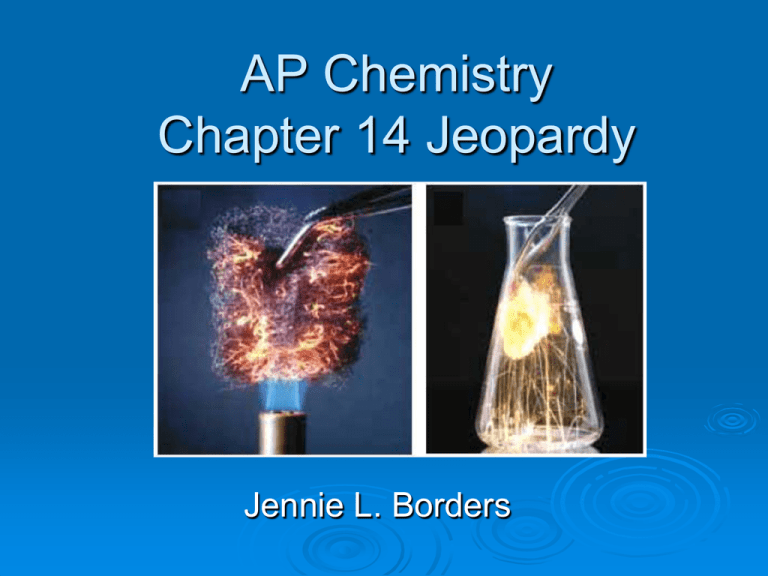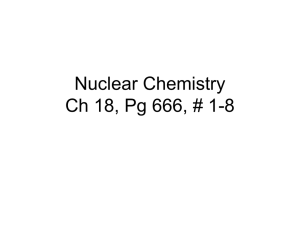AP Chemistry Chapter 6 and 7 Jeopardy
advertisement

AP Chemistry Chapter 14 Jeopardy Jennie L. Borders Round 1 – Chapter 14 Rate Laws Half-Life Graphing Mechanisms Activation Energy Surprise 100 100 100 100 100 100 200 200 200 200 200 200 300 300 300 300 300 300 400 400 400 400 400 400 500 500 500 500 500 500 Rate Laws 100 The reaction 2ClO2 + 2OH- ClO3- + ClO2- + H2O was studied with the following results: Experiment [ClO2] (M) [OH-] (M) Rate (M/s) 1 0.060 0.030 0.0248 2 0.020 0.030 0.00276 3 0.020 0.090 0.00828 Determine the rate law for the reaction. Rate = k[ClO2]2[OH-] Rate Laws 200 The reaction 2ClO2 + 2OH- ClO3- + ClO2- + H2O was studied with the following results: Experiment [ClO2] (M) [OH-] (M) Rate (M/s) 1 0.060 0.030 0.0248 2 0.020 0.030 0.00276 3 0.020 0.090 0.00828 Calculate the rate constant. 229.63 M-2s-1 Rate Laws 300 The reaction 2ClO2 + 2OH- ClO3- + ClO2- + H2O was studied with the following results: Experiment [ClO2] (M) [OH-] (M) Rate (M/s) 1 0.060 0.030 0.0248 2 0.020 0.030 0.00276 3 0.020 0.090 0.00828 Calculate the rate when [ClO2] = 0.1M and [OH-] = 0.05M. 0.115 M/s Rate Laws 400 The following data was measured for the reaction BF3 + NH3 F3BNH3 Experiment [BF3] (M) [NH3] (M) Initial Rate (M/s) 1 0.250 0.250 0.2130 2 0.250 0.125 0.1065 3 0.200 0.100 0.0682 4 0.350 0.100 0.1193 5 0.175 0.100 0.0596 What is the rate law for the reaction? Rate = k[BF3][NH3] Rate Laws 500 The following data was measured for the reaction BF3 + NH3 F3BNH3 Experiment [BF3] (M) [NH3] (M) 1 2 3 4 5 0.250 0.250 0.200 0.350 0.175 0.250 0.125 0.100 0.100 0.100 Initial Rate (M/s) 0.2130 0.1065 0.0682 0.1193 0.0596 What is the rate when [BF3] = 0.100M and [NH3] = 0.500M? 0.1704 M/s Half-Life 100 How do the half-lives of first-order and second-order reactions differ? Since the half-lives of first-order reactions are not based on initial concentration, then all the half-lives are equal. Since the half-lives of second-order reactions are based on initial concentrations, then each halflife is longer than the previous one. Half-Life 200 The gas-phase decomposition of SO2Cl2, SO2Cl2 SO2 + Cl2, is first order in SO2Cl2. At 320oC the rate constant is 2.2 x 10-5 s-1. What is the half-life at this temperature? 31,500s Half-Life 300 Molecular iodine, I2(g), dissociates into iodine atoms at 625K with a firstorder rate constant of 0.271 s-1. What is the half-life of the reaction? 2.56s Half-Life 400 Molecular iodine, I2(g), dissociates into iodine atoms at 625K with a first-order rate constant of 0.271s-1. If you start with 0.050M I2 at this temperature, how much will remain after 5.12s assuming that the iodine atoms do not recombine to form I2? 0.012M Half-Life 500 The first-order rate constant for the decomposition of N2O5, 2N2O5 4NO2 + O2, at 70oC is 6.28 x 10-3 s-1. What is the half-life of N2O5 at 70oC? 110.35s Graphing 100 For a second-order reaction, what quantity, when graphed versus time, will yield a straight line? 1/[A] Graphing 200 Consider the following data: Time (s) Moles of A 0 40 80 120 160 0.100 0.067 0.045 0.030 0.020 Determine whether the reaction is first order or second order. First Order Graphing 300 The gas-phase decomposition of NO2, 2NO2 2NO + O2 is studied at 383oC, given the following data: Time (s) [NO2] (M) 0.0 5.0 10.0 15.0 20.0 0.100 0.017 0.009 0.0062 0.0047 Is the reaction first order or second order with respect to the concentration of NO2? Second Order Graphing 400 At 23oC and in 0.5M HCl, the following data was obtained for the disappearance of sucrose: Time 0 (min) [C12H22O11 0.316 ] (M) 39 80 140 210 0.274 0.238 0.190 0.146 Is the reaction first order or second order with respect to [C12H22O11]? First Order Graphing 500 Is the following reaction first or second order? Second Order Mechanisms 100 The decomposition of hydrogen peroxide is catalyzed by iodide ion. The catalyzed reaction is thought to proceed by a twostep mechanism: H2O2 + I- H2O + IO- (slow) IO- + H2O2 H2O + O2 + I- (fast) Write the chemical equation for the overall process. 2H2O2 2H2O + O2 Mechanisms 200 The decomposition of hydrogen peroxide is catalyzed by iodide ion. The catalyzed reaction is thought to proceed by a twostep mechanism: H2O2 + I- H2O + IO- (slow) IO- + H2O2 H2O + O2 + I- (fast) Predict the rate law for the overall process. Rate = k[H2O2] Mechanisms 300 You find the reaction 4HBr + O2 2H2O + 2Br2 to be first order with respect to HBr and first order with respect to O2. You propose the following mechanism: HBr + O2 HOOBr HOOBr + HBr 2HOBr HOBr + HBr H2O + Br2 Based of the rate law which step is rate determining? Rate = k[HBr][O2] The first step is rate determining. Mechanisms 400 The following mechanism has been proposed for the reaction of NO with H2 to form N2O and H2O: NO + NO N2O2 N2O2 +H2 N2O + H2O The observed rate law is rate = k[NO]2[H2]. What can we conclude about the relative speeds of the first and second reactions? The second step is slow (rate determining) and the first step is fast. Mechanisms 500 Ozone in the upper atmosphere can be destroyed by the following two-step mechanism: Cl + O3 ClO + O2 ClO + O Cl + O2 What is the overall reaction and list any catalysts or intermediates? O3 + O 2O2 Catalyst – Cl Intermediate - ClO Activation Energy 100 What is the activation energy? The difference in energy between the energy to the transition state and the energy of the reactants. Activation Energy 200 The rate of the reaction CH3COOC2H5 + OH- CH3COO- + C2H5OH Was measured at several temperatures, and the following data was collected: Temperature (oC) k(M-1s-1) 15 0.0521 25 0.101 35 0.184 45 0.332 Determine this data, determine Ea. 47,041.61 J/mol Activation Energy 300 The temperature dependence of the rate constant for the reaction is tabulated as follows: Temperature (K) k (M-1s-1) 600 0.028 650 0.22 700 1.3 750 6.0 800 23 Calculate Ea. 133,803.44 J/mol Activation Energy 400 What part of the energy profile of a reaction is affected by a catalyst? Activation energy Activation Energy 500 The oxidation of SO2 to SO3 is catalyzed by NO2. The reaction proceeds as follows: NO2 + SO2 NO + SO3 2NO + O2 2NO2 Why do we consider NO2 a catalyst and not an intermediate in this reaction? NO2 is present at the beginning and end of the reaction. Intermediates are formed during the reaction and used during the reaction. Surprise 100 What are the 4 factors that affect the rate of a reaction? 1.Concentration of reactants 2. Catalysts 3. State of reactants 4. Temperature Surprise 200 The decomposition of N2O5 in carbon tetrachloride proceeds as follows: 2N2O5 4NO2 + O2. The rate law is first order in N2O5. At 64oC the rate constant is 4.82 x 10-3s-1. What happens to the rate when the concentration of N2O5 is doubled? The rate doubles. Surprise 300 Consider the hypothetical reaction between A, B, and C that is first order in A, zero order in B, and second order in C. How does the rate change when [A] is doubled and the other reactant concentrations are held constant? The rate doubles. Surprise 400 Consider the hypothetical reaction between A, B, and C that is first order in A, zero order in B, and second order in C. How does the rate change when [B] is tripled and the other reactant concentrations are held constant? The rate remains the same. Surprise 500 Consider the hypothetical reaction between A, B, and C that is first order in A, zero order in B, and second order in C. By what factor does the rate change when the concentrations of all three reactants are tripled? The rate increases 27 fold.









